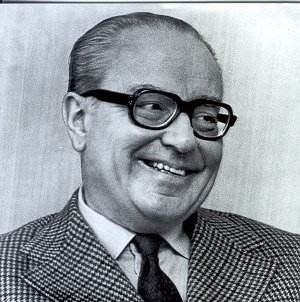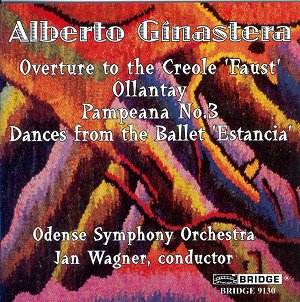Bridge is recording a great deal with the Odense
Symphony Orchestra and its conductor Jan Wagner. This is welcome
news because this flexible ensemble rises to the challenge of
Ginastera’s colour and animation with commendable spirit and,
in the more treacherously introspective waters, they prove themselves
to be an orchestra of depth. The Obertura para el Fausto Criollo
his 1943 gaucho-inspired overture positively bristles with colour
and evocative sense of space. The brass are full of fresh air
drama and the references to Gounod’s Faust are subsumed
into the fabric of the score with self-evident skill; the frolicsome
little fugue is followed by the re-appearance of the brass in
a peroration of rousing drama. Ollantay followed four years
after and is cast in three movements. Inspired by an Inca poem
it takes mythic subject material as its basis and utilises it
in an intensely passionate way. The opening movement is saturated
in melancholy, before dramatic punctuation and intensely hieratic
brass writing. Ginastera builds a vast, flowing declamatory edifice
here, and one that fuses folk elements with precision of scoring
to great effect. The strong ostinati of the second movement, with
the mordant high voicings and percussive interjections, evoke
the warriors (Los guerreros) of the myth – framing the outer movements
as well with this supercharged scherzo. The power and mythic strength
of the Death of Ollantay flood the score with the gleam and glint
of malevolent brass to the pensive high woodwind. A strange middle
section is full of hesitant stasis before some vaguely verdant
wind solos lead on to formidable and brusque brass and a forbidding
end.
Pampeana No. 3 was written for and premiered
by the adventurous Louisville Orchestra under Robert Whitney.
Impressionistic but with strong, formal control Ginastera ensures
that transitions are seamless, that emotive states from reflective
to eruptive emerge naturally from the score. The overarching tone
is one of questing, rather interior reflection in the opening
of the three movements whilst the second movement is again a relentless
ostinato with a contrastive trio section full of intermezzo lightness,
light, frolicsome, gossamer. The finale, a Largo, fuses cantabile
impressionism and a yearning lyricism, and develops an evolutionary
quietude that is most impressive. The scoring per se is masterly.
The Dances from the ballet Estancia conclude this colourful and
evocative disc; variously exhilarating and sultry, with jazzy
sounding off-beats in the Hacienda dance and a blazing Malabo
rhythm conclusion – monstrously driving! But what I most admired
was the Dance of the Wheat, a second movement saturated in swaying
delicacy: lyricism with a capital L, voluptuous and unmistakable.
Jonathan Woolf


![]() for
details
for
details 